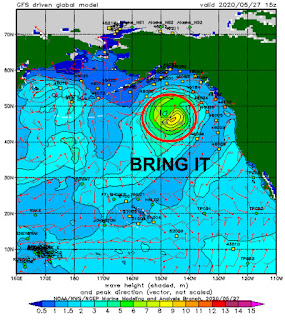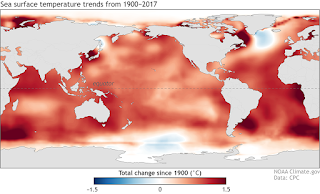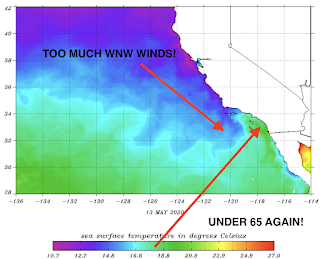Don't make me activate the Emergency Boardriding System...
Fun week of surf if I don't say so myself. Not the biggest, but plenty of shoulder high surf to go around. The sun even peeked out once the May Gray burned off. For the upcoming weekend (and beyond), we've got more fun surf coming. So I'm activating the Emergency Broadcast System.
Starting tomorrow, the SW swell train we've been enjoying lately keeps moving down the tracks and we'll get another shot of shoulder high swell by late in the day.
On Saturday, the SW continues and it's joined by a late season chest high NW. Both swells will give us head high surf through Sunday. The only fly in the ointment is, that weak low pressure system which is giving us that new NW, will also keep the clouds lingering at the beaches all weekend. Small price to pay for good surf. As far as the sun/water temps/tides go, here's what you need to know:
Starting tomorrow, the SW swell train we've been enjoying lately keeps moving down the tracks and we'll get another shot of shoulder high swell by late in the day.
On Saturday, the SW continues and it's joined by a late season chest high NW. Both swells will give us head high surf through Sunday. The only fly in the ointment is, that weak low pressure system which is giving us that new NW, will also keep the clouds lingering at the beaches all weekend. Small price to pay for good surf. As far as the sun/water temps/tides go, here's what you need to know:
- Sunrise and sunset are:
- 5:42 AM sunrise (5:30 AM paddle out)
- 7:51 PM sunset (paddle in 8:00 PM)
- Water temps are finally coming around after all the WNW wind last week and are sitting at 67.
- And tides this weekend are:
- 3' at sunrise
- 0' before lunch
- 4' late afternoon
- 3' at sunset
FORECAST:
The fun combo swells this weekend continue into Monday. The NW backs off Tuesday but we still have fun chest high+ SW.
By Wednesday afternoon, we have yet another good SW showing up.
Thursday has another waist high NW arriving and we're back to head high+ surf from the combo swells. That lasts into Friday.
And after THAT... models show yet another SW forming this weekend which will send shoulder high surf around the 7th (late next Sunday). So again, I'm activating the Emergency Boardriding System. Use it or lose it is what I say.
By Wednesday afternoon, we have yet another good SW showing up.
Thursday has another waist high NW arriving and we're back to head high+ surf from the combo swells. That lasts into Friday.
And after THAT... models show yet another SW forming this weekend which will send shoulder high surf around the 7th (late next Sunday). So again, I'm activating the Emergency Boardriding System. Use it or lose it is what I say.
BEST BET:
This weekend. Middle of next week. Late next weekend. Did I miss anything?
WEATHER:
Nice weather today will turn to May Gray this weekend. Temps will drop to a chilly 70 degrees along the coast due to the clouds hugging the shoreline most of the day. For next week, forecast charts are all over the place with one saying high pressure builds again for great weather while others say May Gray hangs around the beaches. My guess: We'll have low clouds/fog in the nights/mornings and partial sun in the afternoons. Make sure to check out Twitter/North County Surf if anything changes between now and then.
NEWS OF THE WEEK:
As we approach hurricane season, I thought we'd re-visit a topic I've discussed over the years about increasing water temps due to global warming and their potential impacts on the strength of hurricanes. Scientists over the years have been looking into how greenhouse gases, along with another pollutant, tiny particles called aerosols, could affect the strength of tropical cyclones. (The strength, or intensity, of a tropical cyclone is measured by the near-surface wind speed.) What they've come across is a puzzling question: Despite increasing ocean temperatures, why haven’t we seen a similar clear global increase in the strength of tropical cyclones? Here's the National Oceanic and Atmospheric Administration to explain:
Warmer water, stronger storms?
One reason we may expect stronger tropical cyclones is because they draw their strength from warm ocean waters. Warm, moist air above the ocean surface rises and forms thunderstorms. Scientists have long expected that the warmer oceans resulting from global climate change would lead to stronger storms—warmer water, more rising moist air. While the oceans have clearly warmed substantially over the past several decades, very likely due to the heat-trapping effect of greenhouse gases, the global trend in the strength of tropical cyclones doesn’t quite match the sea surface trend. The past few decades or so do appear to show a slight increase in intensity globally, though, and some regions, like the North Atlantic, have shown a steeper pattern of stronger storms.
One reason we may expect stronger tropical cyclones is because they draw their strength from warm ocean waters. Warm, moist air above the ocean surface rises and forms thunderstorms. Scientists have long expected that the warmer oceans resulting from global climate change would lead to stronger storms—warmer water, more rising moist air. While the oceans have clearly warmed substantially over the past several decades, very likely due to the heat-trapping effect of greenhouse gases, the global trend in the strength of tropical cyclones doesn’t quite match the sea surface trend. The past few decades or so do appear to show a slight increase in intensity globally, though, and some regions, like the North Atlantic, have shown a steeper pattern of stronger storms.
But we still can't say for sure that these changes are global-warming related. There are a lot of challenges when it comes to looking for long-term changes in these storms, including the relatively short (about 40 years) satellite observation record—which has its own uncertainties—and the substantial natural year-to-year variations in storm-conducive conditions. For example, El Nino has an impact on hurricanes. Also, of course, these storms are very complex, so there is more at work than just the temperature of the ocean surface. Given the extreme impacts caused by tropical cyclones, though, understanding the possibility of more intense storms in the future as our climate changes is critical.
Introducing… aerosols!
Scientists Adam Sobel and his colleague Suzana Camargo wanted to add to our understanding of the impact on tropical cyclones from another side effect of burning fossil fuels—aerosols, particles tiny enough to float in the air for days or weeks. Aerosols have a long list of different impacts on humans and the environment, including severe health effects. Aerosols can cool the climate by reflecting sunlight back into space, acting in opposition to greenhouse gas warming. Many scientists, dating back to at least 2006, have studied the effect of aerosols on tropical cyclones before, including how aerosols might counteract greenhouse gases.
Introducing… aerosols!
Scientists Adam Sobel and his colleague Suzana Camargo wanted to add to our understanding of the impact on tropical cyclones from another side effect of burning fossil fuels—aerosols, particles tiny enough to float in the air for days or weeks. Aerosols have a long list of different impacts on humans and the environment, including severe health effects. Aerosols can cool the climate by reflecting sunlight back into space, acting in opposition to greenhouse gas warming. Many scientists, dating back to at least 2006, have studied the effect of aerosols on tropical cyclones before, including how aerosols might counteract greenhouse gases.
Potential intensity
Earlier we discussed the recorded strength of tropical cyclones, but now we're going to switch to a slightly different measure—potential intensity, the upper limit to how strong a storm could possibly get. It’s a calculated quantity based on the temperature of the ocean surface and the temperature and humidity of the atmosphere above the ocean. To form the strong thunderstorms within a cyclone, the atmosphere needs to cool with height.
Adam, Suzana, and their team looked at how potential intensity has changed over the past several decades. Studying potential intensity allows us to understand the environment in which the storms are forming. Higher potential intensity can lead to stronger storms, and if potential intensity increases under global warming, we will likely see more intense storms. You can think of potential intensity as an upper limit on growth, but most tropical cyclones don’t reach their full potential intensity, because there are a lot of factors that affect cyclone growth.
Greenhouse gas warming has dominated over aerosol cooling in influencing global ocean temperatures, but what is the dominant factor in driving potential intensity? If aerosol cooling is more active in restraining potential intensity, it could be important for understanding why potential intensity has not yet increased as much as sea surface temperature has. If we can solve that puzzle, then we could get a better idea of what might happen to cyclones if aerosol pollution increases or decreases in the future.
Let’s do some science
Adam’s team used data from computer models that simulate sea surface temperature and tropical cyclone potential intensity from 1850, about when the industrial era began, to near-present. Their study examined global patterns, while many earlier studies focused on the Atlantic. Four different scenarios were considered: 1) What if we never started burning fossil fuels? (i.e., no greenhouse gases, no aerosols) 2) What if we emitted greenhouse gases but not aerosols? 3) What if we emitted aerosols but not greenhouse gases? and 4) What does it look like with both greenhouse gases and aerosols?
Let’s start with the simplest: If we hadn’t started burning fossil fuels, both sea surface temperature and potential intensity would have remained about the same from 1850 to now. But if we look at what happens with both greenhouse gases and aerosols—that is, reality, scenario 4)—sea surface temperature has clearly increased, but potential intensity hasn’t. It’s wobbled around quite a bit, but we don’t see the same clear upward trend as sea surface temperature until the last couple of decades.
It’s when we look at scenarios 2) and 3) that things get pretty interesting. The computer model shows that the warming effect from greenhouse gases on sea surface temperature is two to three times bigger than the cooling effect of aerosols. However, the increase to potential intensity caused by greenhouse gases is just about equal to the decrease caused by aerosols. Aerosols have complex interactions with the atmosphere, more than just reflecting sunlight back into space, including warming the atmosphere and affecting humidity. This means they have a stronger impact on restraining cyclone intensity than they do on counteracting ocean warming, partly explaining why the trend in cyclone strength doesn’t closely match the trend in sea surface temperature.
Aerosols aren’t really great
Despite somewhat countering both global warming and cyclone strength, aerosol pollution isn’t a good thing, likely causing millions of deaths per year. Policy and technological changes have led to reductions in aerosols in the US and Europe, even as greenhouse gas emissions continue to rapidly increase. So it’s likely that the restraining effect of aerosols on cyclone potential intensity will decrease in the future, and we may see more intense tropical cyclones.
There are many open questions about tropical cyclones—for example, we have no idea why approximately 90 storms form across the globe each year. Why not seven? Why not 400? These storms are as mysterious as they are powerful. Fortunately, there is a lot of ongoing research, so our understanding is growing every day.
It’s when we look at scenarios 2) and 3) that things get pretty interesting. The computer model shows that the warming effect from greenhouse gases on sea surface temperature is two to three times bigger than the cooling effect of aerosols. However, the increase to potential intensity caused by greenhouse gases is just about equal to the decrease caused by aerosols. Aerosols have complex interactions with the atmosphere, more than just reflecting sunlight back into space, including warming the atmosphere and affecting humidity. This means they have a stronger impact on restraining cyclone intensity than they do on counteracting ocean warming, partly explaining why the trend in cyclone strength doesn’t closely match the trend in sea surface temperature.
Aerosols aren’t really great
Despite somewhat countering both global warming and cyclone strength, aerosol pollution isn’t a good thing, likely causing millions of deaths per year. Policy and technological changes have led to reductions in aerosols in the US and Europe, even as greenhouse gas emissions continue to rapidly increase. So it’s likely that the restraining effect of aerosols on cyclone potential intensity will decrease in the future, and we may see more intense tropical cyclones.
There are many open questions about tropical cyclones—for example, we have no idea why approximately 90 storms form across the globe each year. Why not seven? Why not 400? These storms are as mysterious as they are powerful. Fortunately, there is a lot of ongoing research, so our understanding is growing every day.
























































